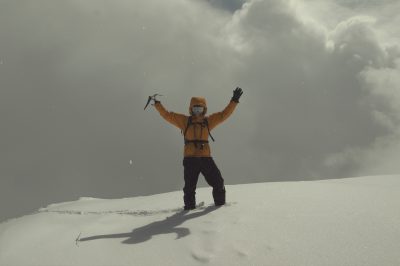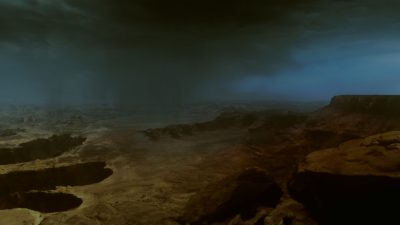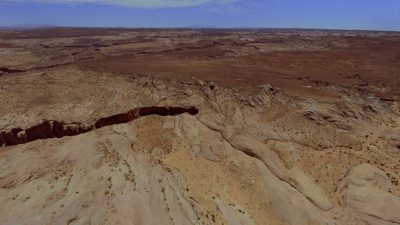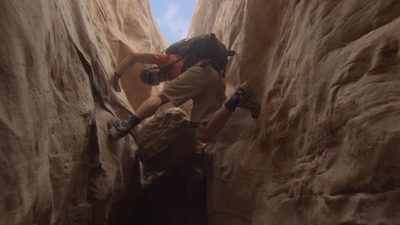Danny Boyle’s 127 Hours is the story of mountain climber Aron Ralston (James Franco) who becomes trapped beneath a boulder in Utah. We talk to VFX supe Adam Gascoyne from Union Visual Effects about how his studio helped tell this real-life tale of survival.
fxg: The effects in 127 Hours feel seamless, but also seem to add to the frenetic nature of the filmmaking – what were some of the early considerations you or the director had in terms what the VFX could help him achieve?
Gascoyne: We met with Danny Boyle just after he had drafted the first pass of the script. He had areas where VFX were obviously needed, such as the arm removal, but looked to us for help solving some of other issues which arose due to the location. 127 Hours is, on the face of it, not a big VFX movie but once you start looking into the locations and the subject matter you realise that it is a really tricky movie to make. Just getting to the locations took a herculean effort, so thats where the effects were used, to solve difficult production issues and help maintain the reality which was key to the story.
 fxg: How many shots were there in total, and what was the production time and crew size?
fxg: How many shots were there in total, and what was the production time and crew size?
Gascoyne: We worked on over 400 shots with 350 making it into the final cut. After returning from Utah we had a schedule of 3 months and a crew of 20 working on the project.
fxg: What kind of set or environment extensions were required, and how did you match these to the confined spaces and the camera work in the film?
Gascoyne: Early in pre-production we had a LIDAR scan done of the real location which was used alongside some real casts of the canyon walls to recreate the canyon in Salt Lake City. This set was an exact replica of the immediate area around where Aron was trapped. We had very small SI 2k cameras being expertly operated by Anthony Dod Mantle and Enrique Chediak on custom made rigs, in very crammed spaces. All the canyon shots required some extending when we saw off the set, this was a challenge due to the free reign of the camera and the lenses used.
All these things stemmed from the restrictions dictated by the landscape Aron was stuck in. It was made clear by Danny Boyle to all of the crew early in the planning stage this was an important part of making this film and there were no easy ways out of problems, but it shows in the final movie I think. If we could have moved walls or fit an entire camera crew into the space we would have lost a lot of the feelings of claustrophobia and isolation.
We used a LIDAR of the set, textured it in Maya, and then transferred it to Nuke to render all the set extensions. Matters were complicated by the fact there was no room for a green screen above the canyon set. Because of its shape the lighting rigs had to go right above it, the only way of lighting it evenly was to use white silks, so we had silks as opposed to green screens, which was…interesting.
 fxg: Can you talk about some of the digital environments, weather and atmosphere that was created?
fxg: Can you talk about some of the digital environments, weather and atmosphere that was created?
Gascoyne: We created many CG environments for the movie. During the storm sequence these were used to show impossible angles of the storm approaching. We had some picture references from Danny as to how the cloud bank should look. We took plate shots from a hot air balloon about a mile up in the air. These were used in digital matte paintings which were projected onto basic geometry of the region generated from height field data. We worked with Jim Bowers to create cloud movement and weather effects for the storm sequence using Terragen.
fxg: How was the pull-out from the canyon shot and then achieved as a visual effect?
Gascoyne: The first part of that shot was filmed in the canyon set in Salt Lake City. We then we shot plates from a helicopter at various heights above the actual accident site in Blue John Canyon, Utah. As with the storm sequence, these plates were then projected onto geometry generated from height field data of the area. This allowed us to soar above and through the canyon lands which was impossible to film with such freedom.
 fxg: There are some shots of Aron turning to dust – what were the tools and techniques you used for these shots?
fxg: There are some shots of Aron turning to dust – what were the tools and techniques you used for these shots?
Gascoyne: Aron turning to dust during the latter stages of his decline was the most time consuming of all the shots we did. They involved a lot of work with Maya fluid and cloth simulation. We had a cyberscan of James Franco which helped and also a LIDAR scan of the canyon set to ensure the fluids interacted correctly with the surroundings.
fxg: How did you approach the limb removals and prosthetic enhancements in the film?
Gascoyne: It was always the plan to capture as much of the amputation as possible in camera. We worked closely with the physical effects make-up guys from Alterian, who’d built a prosthetic arm that was used on set. Our work entailed blood addition and tidying up the edges of the silicon, and adding more connective tissue. Also, maintaining the look, keeping it completely consistent throughout the sequence was vital, and the results have spurred spontaneous applause in many screenings! For the swimming shots we did a lot of work painting out James Franco’s arm. When we had a clean base we projected textures taken of Aron’s arm onto basic models inside Nuke. With help from Maya and a lot of compositing we managed to achieve some excellent results.
 fxg: Finally, can you tell me a little about the history of Union Visual Effects?
fxg: Finally, can you tell me a little about the history of Union Visual Effects?
Gascoyne: Tim Caplan, our visual effects producer, and I started up Union Visual Effects in October 2008. Tim had just finished working for Universal on Mamma Mia and I had just supervised the VFX on Slumdog Millionaire with Danny Boyle. The depths of a recession might not look like the best time to open for business, but we felt that, with the right people and kit, there was room for a quality small outfit. Throughout 2009 we worked on various projects including Stephan Poliakoff’s Glorious 39 and Peter Mullan’s Neds. Late 2009 saw us starting work on 127 Hours, and shortly after that we moved to our current premises in Wardour Street, London.
Images courtesy of Fox Searchlight Pictures.

I would love to know where the rain scenes were shot – if those scenes with the canyon flooded were in a studio. Must have been…
Pingback: ERIC ALBA | Union’s 350 #vfx shots for 127 Hours